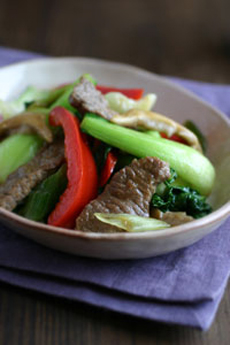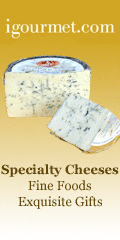
|
KAREN HOCHMAN is Editorial Director of THE NIBBLE.
|
|
September 2006
Last Updated March 2012
|
 |
Umami Foods
Page 4: Which Foods Have Umami Flavor
This is Page 4 of a six-page article. Click on the black links below to visit other pages.
Foods With Umami
Before we look at the umami-rich foods in our everyday diet, let’s take a look at these not-so-everyday umami-rich foods:
- Foods made from fermented beans or grains: soy sauce and miso sauce
- Foods made from fermented seafood: anchovy and cod roe paste in Scandinavia, the Asian fish sauces noted on the previous page
But unless you eat a diet rich in Asian foods or Scandinavian fish pastes, you don’t eat most of these often. Before we look at how the concept of umami translates into everyday Western foods, here’s a bit of a pep talk:
- It’s easy to understand sweet, salty, bitter or sour when you taste it—it jumps out at you.
- Umami is more vague. While all fruit and candy, for example, exhibit some sweetness, not all cheeses or vegetables will shout “umami.” A tomato is meaty, celery is not. The meatiness of a lamb shank or a beef stew easily says “umami”; a delicate poached chicken breast doesn’t make the same kind of statement.
- You’re looking for glutamate, the flavor of MSG. It requires some palate training, like learning to recognize the tannin and acid components of wine.
Condiments
Bouillon cubes, ketchup, MSG, steak sauce and Worcestershire sauce are glutamate-laden food-enhancers. In Australia, glutamate-dense yeast extracts like Vegemite and Marmite are spread on buttered bread and eaten the way we enjoy peanut butter. You’ll read more about some of them in the sections below.
Dairy Products
Cow’s, goat’s and sheep’s milk are rich in glutamates. When the milk is cultured and aged to produce cheese, the glutamic acid is further liberated, with a corresponding boost in flavor.
- That’s why more aged cheeses— cheddar, emmental, gruyère, parmesan, romano, e.g.—are used as seasoning cheeses, grated over or stirred into other dishes, or used as toppings to add savory flavor.
- Other cheeses, such as the mold-cured blues, lend distinctive glutamate-rich flavors.
- While cultured dairy products such as yogurt and sour cream are used in many Western cuisines, they are a less concentrated source of glutamate than aged cheese. But their flavor is enhanced by the unique tang of lactic acid, and they are a traditional umami food.
|
|
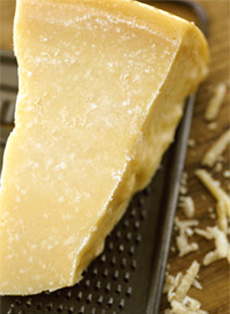
The small white crystals on the surface of a piece of parmesan cheese are glutamate, crystals which are formed during maturation.
Photo of cheese and of tomato above courtesy of The Umami Information Center. |
Cured Pork Products
Bacon, ham, ham hocks, salt pork, sausages and other cured pork products are fundamentals in the umami arsenal. By themselves or as additions to beans, stews, soups, potatoes, rice dishes and other foods, most Western cuisines use some kind of sausage. Each country or region has a specialty: think English country sausages, French charcuterie, Italian pepperoni, German wursts, Polish kielbasa and Spanish chorizo.
- Cured pork products are part of our daily life, from bacon, ham or sausage with breakfast to ham, bologna or salami sandwich at lunch to a dinner ham, sausages in a pasta sauce or a pepperoni pizza.
- Sausage has been embraced in American regional cooking, from southern collard greens with smoked ham hocks, German-style potato salad with bacon, Creole jambalaya and Cuban black beans with ham.
Fish
While garum died out with the Roman empire, it lives on in other forms: anchovies, anchovy paste, dried shrimp in Latin American cuisine and the various fish sauces of Asia.
- Anchovies are extremely popular in southern Italy, Sicily and southern France as a flavor-enhancer in sauces and with meat, vegetables, and pasta, pizza, salads and hors d’oeuvres. In paste form it is added to sauces, salad dressings and spreads like anchovy butter. It is a component of condiment such as Worcestershire and steak sauces. (The top-quality white anchovies sown at the right area treat for anchovy-lovers. Click here for more information.)
- Anchovy paste and other fish pastes like cod roe paste are basics in Scandinavian cuisine.
- Dried shrimp is used in soups, stews and mixed rice dishes in Central and South American and the Caribbean to provide a fuller, richer flavor.
- The intense, meaty seafood broths—bouillabaisse, gumbo, sopa de mariscos, et al—are the closest Western equivalent to a Japanese dashi, full of sea-based glutamates.
|
|
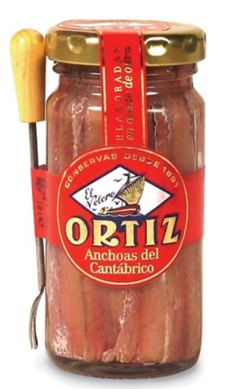
Top-quality anchovies from Ortiz are available on Amazon.com. |
Meats
Beef stock is a classic example of umami. The flesh and bones, boiled with vegetables, herbs and spices, form the basis of great sauces, stocks and soups.
- Stocks can be made from veal, chicken and other meats as well. Strained and clarified, they makes broth or bouillon (from the French bouilli, boiled).
- These glutamate-rich liquids also can be reduced into concentrates, from glace de viande to commercially bottled concentrates (Bovril, e.g.).
- A cheeseburger with tomato and ketchup provides three sources of umami: meaty beef, aged cheddar, perhaps a slice of tomato and lots of tomato ketchup.
- Pork is as equally full of glutamic acid as other meats, but is most known as an umami agent in its cured form.
Mushrooms
Earthy-flavored mushrooms vary by type in glutamate content, but most contain substantial amounts. The highest content is owned by the shiitake, Japan’s most popular mushroom.
When mushrooms are dried, their guanylate content increases, further boosting their umami flavor. The liquid from re-hydrated dried mushrooms is very rich in umami and is widely used to make dashi and other stock.
|
|
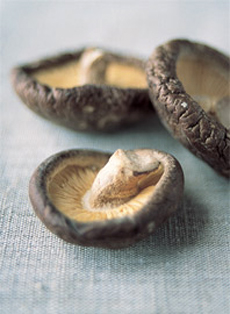
Photo of shiitake mushrooms courtesy of The Umami Information Center. |
Tomatoes
One hardly thinks “umami” when thinking of the tomato; but a true, farm-raised tomato has a “beefy” flavor that comes from a heavy concentration of glutamates. Delicious by itself, it is used in condiment form (ketchup) and as a paste to enhance soups, stews and sauces.
While the tomato is indigenous to Peru and Ecuador*, it has taken root the world over.
- Ketchup, one of the most ubiquitous tomato-based foods, originated in Southeast Asia; kecap is the Indonesian word for soy sauce. When kecap was brought back to England by sailors, it was remade with local ingredients such as walnuts and mushrooms; when it traveled to America the condiment was remade with the local tomato.
|
|

Tomato. Photo courtesy of The Umami Information Center. |
- Tomato sauce on pasta with parmesan cheese is a double-umami hit. A pizza with tomato sauce, cheese and pepperoni, sausage, mushrooms or anchovies is a triple or a perhaps a home run, depending on the number of toppings one chooses.
*Called tomatl by the native Americans), the tomato was brought to Spain by Christopher Columbus and later by Hernando Cortès, and then to Italy where they earned the name pomi d’oro, or golden apple, because the original varieties were yellow. It was originally used for medicinal purposes and had a reputation for being poisonous; but it was assumed for years to be poisonous in Italy, where it was grown as a decorative plant. Eventually the peasant classes discovered that it could be eaten when food was scarce. This eventually (and thankfully!) developed into the famed Italian cuisine of tomato dishes: by the 18th century the tomato had become an indispensable ingredient of Italian cuisine. Across the sea, by 1799, it was being used to make catsup in New Orleans. In the U.K., Worcestershire sauce was made from tomatoes and other vegetables, and this was eventually exported to America, along with tomato sauce and paste, where a variety of processed foods such as ketchup and chili sauce were produced. Today, tomatoes are one of the most widely produced vegetables on the planet and their umami taste is appreciated all over the world.
Glutamate Content Chart
Here is the comparative glutamate content in the natural forms of these foods:
| Category |
mg/100g |
|
mg/100g |
|
mg/100g |
| Beef |
107 |
Mackerel |
215 |
Sea Bream |
215 |
| Bonito |
285 |
Mushroom (Enokitake) |
21.8 |
Seaweed, Nori |
1378 |
| Bonito (Dried) |
26 |
Mushroom (Shiitake-Fresh) |
67 |
Seaweed, Wakame |
8.62 |
| Carrots |
33
|
Mushroom (Shiitake-Dried) |
|
Soybean |
66
|
| Cabbage (Chinese) |
100
|
Parmesan Cheese |
1200 |
Squid |
146
|
| Chicken |
76 |
Oyster |
137 |
Sweet Potato |
60 |
| Clam |
41 |
Pork |
122 |
Tomato |
140 |
| Cod |
44 |
Prawn |
43 |
Tomato Juice |
260 |
| Green Tea |
668 |
Potato |
102 |
Truffle |
8.5 |
| Kombu (Seaweed) |
2204 |
Sardine |
280 |
Tuna |
188 |
| |
|
Sardine (Dried) |
50 |
|
|
| |
|
|
|
|
|
Continue To Page 5: Umami Recipes
Go To The Article Index Above

|




